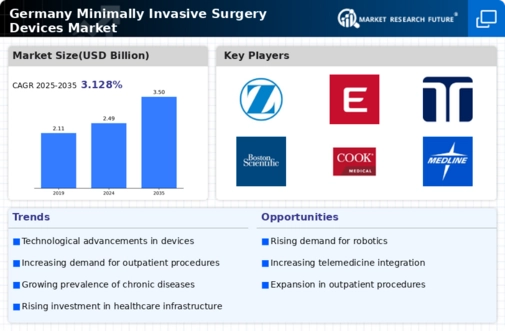Government Initiatives and Funding
Government initiatives and funding aimed at enhancing healthcare infrastructure significantly impact the minimally invasive-surgery-devices market. In Germany, the government has been actively promoting the adoption of advanced medical technologies through various funding programs and incentives. These initiatives are designed to improve healthcare delivery and patient outcomes, thereby encouraging hospitals to invest in minimally invasive surgical devices. Reports suggest that public funding for healthcare technology has increased by approximately 15% over the past few years, facilitating the acquisition of innovative surgical devices. This supportive environment is likely to foster growth in the minimally invasive-surgery-devices market, as healthcare facilities seek to modernize their surgical capabilities.
Aging Population and Surgical Needs
The aging population in Germany is a critical driver for the minimally invasive-surgery-devices market. As the demographic landscape shifts, the demand for surgical interventions is expected to rise, particularly for age-related conditions such as joint disorders and cardiovascular diseases. Statistics indicate that by 2030, nearly 30% of the German population will be over 65 years old, creating a substantial need for effective surgical solutions. Minimally invasive procedures are particularly appealing for older patients due to their lower risk profiles and quicker recovery times. This demographic trend suggests a growing market for minimally invasive surgical devices, as healthcare providers adapt to meet the needs of an aging population.
Rising Prevalence of Chronic Diseases
The increasing prevalence of chronic diseases in Germany is a significant driver for the minimally invasive-surgery-devices market. Conditions such as cardiovascular diseases, diabetes, and obesity necessitate surgical interventions, which are increasingly performed using minimally invasive techniques. According to health statistics, chronic diseases affect approximately 40% of the German population, leading to a heightened demand for effective surgical solutions. This trend is likely to propel the adoption of minimally invasive devices, as they offer reduced recovery times and lower complication rates compared to traditional surgeries. Furthermore, the healthcare system's focus on improving patient outcomes aligns with the capabilities of these devices, suggesting a robust growth trajectory for the market in the coming years.
Technological Innovations in Surgical Devices
Technological innovations play a crucial role in shaping the minimally invasive-surgery-devices market. Advancements in robotics, imaging technologies, and surgical instruments enhance the precision and effectiveness of minimally invasive procedures. For instance, the integration of robotic-assisted surgery has shown to improve surgical outcomes, with studies indicating a reduction in hospital stay durations by up to 30%. Additionally, the development of advanced imaging techniques allows for better visualization during surgeries, further driving the adoption of these devices. As hospitals in Germany increasingly invest in cutting-edge technologies, the market for minimally invasive surgical devices is expected to expand significantly, catering to the evolving needs of healthcare providers and patients alike.
Patient Preference for Less Invasive Procedures
There is a notable shift in patient preference towards less invasive surgical options, which serves as a key driver for the minimally invasive-surgery-devices market. Patients are increasingly aware of the benefits associated with minimally invasive procedures, such as shorter recovery times, reduced pain, and minimal scarring. Surveys indicate that over 70% of patients express a preference for minimally invasive options when presented with surgical choices. This growing awareness is influencing healthcare providers to adopt these techniques more widely, thereby boosting the demand for minimally invasive devices. As patient-centric care continues to gain traction in Germany, the market is likely to experience sustained growth, driven by this shift in patient expectations.





















Leave a Comment